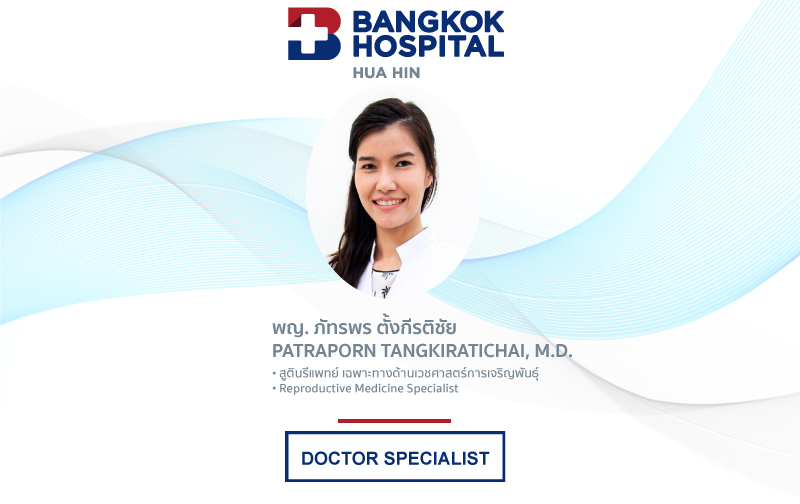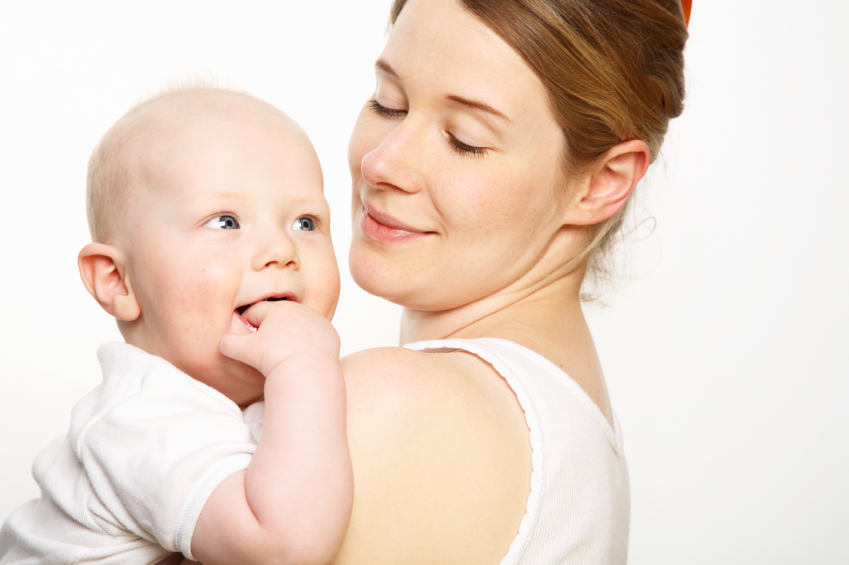How New Mothers Deal with Postpartum Disorders
The postpartum period starts from the time the baby and placenta are delivered until 6 to 8 weeks later. It is the duration when women’s body returns from all the changes caused by pregnancy. However, all body systems may not completely return to its normal conditions prior to the pregnancy.
 Dr. Patraporn Tangkiratichai, our obstetrician-gynecologist and reproductive medicine specialist at Bangkok Hospital Hua Hin shares that the postpartum period is important to all mothers. Besides caring for the baby, mothers must also handle the changes in their bodies. However, each mother may experience different symptoms and conditions after giving birth. The list is as follows;
Postpartum pain is a common problem following childbirth, it can occur in both vaginal delivery or cesarean section. The most common cause is uterine contraction and it becomes more painful during breast feeding due to the secretion of the oxytocin hormone. This symptom can be relieved by taking a painkiller.
Endometritis can occur due to a long painful labor, prolonged rupture of the amniotic membrane, frequent vaginal examinations during the labor, the passing meconium of the baby, manual removal of the placenta and in mothers with diabetes. These are risk factors of uterine infection and endometritis. The symptoms include fever, lower abdominal pain and tenderness. Additionally, lochia may look different with unusual smells. The uterus may have decreased tone and contraction causing excessive vaginal bleeding. If any of these symptoms occur, you need to consult a doctor for immediate intervention.
Breast pain is a common problem and can cause mothers to discontinue breastfeeding. It can happen from various reasons such as:
Dr. Patraporn Tangkiratichai, our obstetrician-gynecologist and reproductive medicine specialist at Bangkok Hospital Hua Hin shares that the postpartum period is important to all mothers. Besides caring for the baby, mothers must also handle the changes in their bodies. However, each mother may experience different symptoms and conditions after giving birth. The list is as follows;
Postpartum pain is a common problem following childbirth, it can occur in both vaginal delivery or cesarean section. The most common cause is uterine contraction and it becomes more painful during breast feeding due to the secretion of the oxytocin hormone. This symptom can be relieved by taking a painkiller.
Endometritis can occur due to a long painful labor, prolonged rupture of the amniotic membrane, frequent vaginal examinations during the labor, the passing meconium of the baby, manual removal of the placenta and in mothers with diabetes. These are risk factors of uterine infection and endometritis. The symptoms include fever, lower abdominal pain and tenderness. Additionally, lochia may look different with unusual smells. The uterus may have decreased tone and contraction causing excessive vaginal bleeding. If any of these symptoms occur, you need to consult a doctor for immediate intervention.
Breast pain is a common problem and can cause mothers to discontinue breastfeeding. It can happen from various reasons such as:
 Postpartum hemorrhage is a condition when the pregnant woman experiences massive blood loss after childbirth. It can happen after vaginal delivery or cesarean section. There are two types of postpartum hemorrhages as follows,
1) “Primary postpartum hemorrhage” occurs within the first 24 hours after delivery and can be found in 1 – 5% of deliveries approximately.
2) “Secondary postpartum hemorrhage” occurs after 24 hours but not later than 12 weeks after delivery which can be found in 0.5 – 2% of deliveries approximately.
The majority of hemorrhages are caused by uterine atony which occur when the uterus expands more than usual, such as in twin pregnancies. Other causes include vaginal tears, retained placenta, or blood clotting disorders. The symptoms vary depending on the amount of blood loss such as exhaustion, dizziness, shortness of breath, restlessness and it can be life-threatening. The treatments are based on the causes of the hemorrhage. If uterine atony is the cause, massaging the uterus along with the use of medication helps with uterine contraction. In severe cases, the patient requires blood transfusion and in the worst scenario, surgical removal of the uterus may be necessary to save the mother’s life.
Postpartum hemorrhage is a condition when the pregnant woman experiences massive blood loss after childbirth. It can happen after vaginal delivery or cesarean section. There are two types of postpartum hemorrhages as follows,
1) “Primary postpartum hemorrhage” occurs within the first 24 hours after delivery and can be found in 1 – 5% of deliveries approximately.
2) “Secondary postpartum hemorrhage” occurs after 24 hours but not later than 12 weeks after delivery which can be found in 0.5 – 2% of deliveries approximately.
The majority of hemorrhages are caused by uterine atony which occur when the uterus expands more than usual, such as in twin pregnancies. Other causes include vaginal tears, retained placenta, or blood clotting disorders. The symptoms vary depending on the amount of blood loss such as exhaustion, dizziness, shortness of breath, restlessness and it can be life-threatening. The treatments are based on the causes of the hemorrhage. If uterine atony is the cause, massaging the uterus along with the use of medication helps with uterine contraction. In severe cases, the patient requires blood transfusion and in the worst scenario, surgical removal of the uterus may be necessary to save the mother’s life.
 Postpartum depression typically begins within one month after giving birth. Mothers will feel sad, bad, hopeless, and irritable for most days without any desire to do things they used to enjoy. A mild depressive symptom in some mothers, referred to as postpartum blues, it occurs a few days after giving birth and is characterized by a bad mood, restlessness, nervousness, lack of concentration, sleep problems, and crying. These symptoms are mild and will disappear in two weeks. Some symptoms of postpartum depression are similar to those of general postpartum stress, such as lack of sleep, tiredness, exhaustion, changes in appetite or sexual desire. However, in postpartum depression, there are components of anxiety, restlessness, anger, guilt, inability to care for the child, and feeling like a failure as a mother. If you have strong feelings that you want to hurt or kill yourself, you must seek medical attention as soon as possible.
“The postpartum period is important for every mother and each mother may experience various postpartum symptoms. If you have any problems or concerns, it is recommended that you consult an obstetrician-gynecologist for appropriate advice, which may range from behavior modification to medications or treatments in order to regain health to provide loving care to their children. Dr. Patraporn concluded.
**************************************************************************
For more information and booking an appointment, please contact :
Tel. 032-616-800 Call Center, Bangkok Hospital Hua Hin
Tel: 032-616-884 (8.00 – 17.00 hrs.) OBGYN Department, 3rd floor
Line : @bangkokhuahin or https://lin.ee/5tso2l0
Postpartum depression typically begins within one month after giving birth. Mothers will feel sad, bad, hopeless, and irritable for most days without any desire to do things they used to enjoy. A mild depressive symptom in some mothers, referred to as postpartum blues, it occurs a few days after giving birth and is characterized by a bad mood, restlessness, nervousness, lack of concentration, sleep problems, and crying. These symptoms are mild and will disappear in two weeks. Some symptoms of postpartum depression are similar to those of general postpartum stress, such as lack of sleep, tiredness, exhaustion, changes in appetite or sexual desire. However, in postpartum depression, there are components of anxiety, restlessness, anger, guilt, inability to care for the child, and feeling like a failure as a mother. If you have strong feelings that you want to hurt or kill yourself, you must seek medical attention as soon as possible.
“The postpartum period is important for every mother and each mother may experience various postpartum symptoms. If you have any problems or concerns, it is recommended that you consult an obstetrician-gynecologist for appropriate advice, which may range from behavior modification to medications or treatments in order to regain health to provide loving care to their children. Dr. Patraporn concluded.
**************************************************************************
For more information and booking an appointment, please contact :
Tel. 032-616-800 Call Center, Bangkok Hospital Hua Hin
Tel: 032-616-884 (8.00 – 17.00 hrs.) OBGYN Department, 3rd floor
Line : @bangkokhuahin or https://lin.ee/5tso2l0
 Dr. Patraporn Tangkiratichai, our obstetrician-gynecologist and reproductive medicine specialist at Bangkok Hospital Hua Hin shares that the postpartum period is important to all mothers. Besides caring for the baby, mothers must also handle the changes in their bodies. However, each mother may experience different symptoms and conditions after giving birth. The list is as follows;
Postpartum pain is a common problem following childbirth, it can occur in both vaginal delivery or cesarean section. The most common cause is uterine contraction and it becomes more painful during breast feeding due to the secretion of the oxytocin hormone. This symptom can be relieved by taking a painkiller.
Endometritis can occur due to a long painful labor, prolonged rupture of the amniotic membrane, frequent vaginal examinations during the labor, the passing meconium of the baby, manual removal of the placenta and in mothers with diabetes. These are risk factors of uterine infection and endometritis. The symptoms include fever, lower abdominal pain and tenderness. Additionally, lochia may look different with unusual smells. The uterus may have decreased tone and contraction causing excessive vaginal bleeding. If any of these symptoms occur, you need to consult a doctor for immediate intervention.
Breast pain is a common problem and can cause mothers to discontinue breastfeeding. It can happen from various reasons such as:
Dr. Patraporn Tangkiratichai, our obstetrician-gynecologist and reproductive medicine specialist at Bangkok Hospital Hua Hin shares that the postpartum period is important to all mothers. Besides caring for the baby, mothers must also handle the changes in their bodies. However, each mother may experience different symptoms and conditions after giving birth. The list is as follows;
Postpartum pain is a common problem following childbirth, it can occur in both vaginal delivery or cesarean section. The most common cause is uterine contraction and it becomes more painful during breast feeding due to the secretion of the oxytocin hormone. This symptom can be relieved by taking a painkiller.
Endometritis can occur due to a long painful labor, prolonged rupture of the amniotic membrane, frequent vaginal examinations during the labor, the passing meconium of the baby, manual removal of the placenta and in mothers with diabetes. These are risk factors of uterine infection and endometritis. The symptoms include fever, lower abdominal pain and tenderness. Additionally, lochia may look different with unusual smells. The uterus may have decreased tone and contraction causing excessive vaginal bleeding. If any of these symptoms occur, you need to consult a doctor for immediate intervention.
Breast pain is a common problem and can cause mothers to discontinue breastfeeding. It can happen from various reasons such as:
- Breast engorgement which is caused by swelling of breast tissues and retained breast milk leading to a low-grade fever and pain. The best treatment is a continuous relief by breast feeding or breast pumps. If the breasts are enlarged, it may flatten the nipples causing more difficulties for the baby to suck on. With poor fitting of the baby’s mouth and the nipple, it may lead to nipple’s injuries. A cold compress with painkillers is recommended for relieving the symptoms. Hot compresses, on the other hand, may make it worse. The heat can help to reduce pain and increase milk flow but it will also cause more tissue swelling. If the breasts are engorged for a long time with the presence of swelling, redness, tenderness, or fever, mastitis or breast abscess are to be suspected. The mother should see a doctor immediately for a diagnosis and treatments.
- Sore nipples are caused by two reasons. The nipples become more sensitive after childbirth but should improve in 4 to 7 days. This sensitivity should disappear 30 seconds to 1 minute after the breastfeeding starts. The other one is nipple injuries which are caused by incorrect breastfeeding techniques. The pain is constant and may increase and last more than 7 days. This may be related to infection and requires proper treatments such as topical cream as recommended by the doctor.
 Postpartum hemorrhage is a condition when the pregnant woman experiences massive blood loss after childbirth. It can happen after vaginal delivery or cesarean section. There are two types of postpartum hemorrhages as follows,
1) “Primary postpartum hemorrhage” occurs within the first 24 hours after delivery and can be found in 1 – 5% of deliveries approximately.
2) “Secondary postpartum hemorrhage” occurs after 24 hours but not later than 12 weeks after delivery which can be found in 0.5 – 2% of deliveries approximately.
The majority of hemorrhages are caused by uterine atony which occur when the uterus expands more than usual, such as in twin pregnancies. Other causes include vaginal tears, retained placenta, or blood clotting disorders. The symptoms vary depending on the amount of blood loss such as exhaustion, dizziness, shortness of breath, restlessness and it can be life-threatening. The treatments are based on the causes of the hemorrhage. If uterine atony is the cause, massaging the uterus along with the use of medication helps with uterine contraction. In severe cases, the patient requires blood transfusion and in the worst scenario, surgical removal of the uterus may be necessary to save the mother’s life.
Postpartum hemorrhage is a condition when the pregnant woman experiences massive blood loss after childbirth. It can happen after vaginal delivery or cesarean section. There are two types of postpartum hemorrhages as follows,
1) “Primary postpartum hemorrhage” occurs within the first 24 hours after delivery and can be found in 1 – 5% of deliveries approximately.
2) “Secondary postpartum hemorrhage” occurs after 24 hours but not later than 12 weeks after delivery which can be found in 0.5 – 2% of deliveries approximately.
The majority of hemorrhages are caused by uterine atony which occur when the uterus expands more than usual, such as in twin pregnancies. Other causes include vaginal tears, retained placenta, or blood clotting disorders. The symptoms vary depending on the amount of blood loss such as exhaustion, dizziness, shortness of breath, restlessness and it can be life-threatening. The treatments are based on the causes of the hemorrhage. If uterine atony is the cause, massaging the uterus along with the use of medication helps with uterine contraction. In severe cases, the patient requires blood transfusion and in the worst scenario, surgical removal of the uterus may be necessary to save the mother’s life.
 Postpartum depression typically begins within one month after giving birth. Mothers will feel sad, bad, hopeless, and irritable for most days without any desire to do things they used to enjoy. A mild depressive symptom in some mothers, referred to as postpartum blues, it occurs a few days after giving birth and is characterized by a bad mood, restlessness, nervousness, lack of concentration, sleep problems, and crying. These symptoms are mild and will disappear in two weeks. Some symptoms of postpartum depression are similar to those of general postpartum stress, such as lack of sleep, tiredness, exhaustion, changes in appetite or sexual desire. However, in postpartum depression, there are components of anxiety, restlessness, anger, guilt, inability to care for the child, and feeling like a failure as a mother. If you have strong feelings that you want to hurt or kill yourself, you must seek medical attention as soon as possible.
“The postpartum period is important for every mother and each mother may experience various postpartum symptoms. If you have any problems or concerns, it is recommended that you consult an obstetrician-gynecologist for appropriate advice, which may range from behavior modification to medications or treatments in order to regain health to provide loving care to their children. Dr. Patraporn concluded.
**************************************************************************
For more information and booking an appointment, please contact :
Tel. 032-616-800 Call Center, Bangkok Hospital Hua Hin
Tel: 032-616-884 (8.00 – 17.00 hrs.) OBGYN Department, 3rd floor
Line : @bangkokhuahin or https://lin.ee/5tso2l0
Postpartum depression typically begins within one month after giving birth. Mothers will feel sad, bad, hopeless, and irritable for most days without any desire to do things they used to enjoy. A mild depressive symptom in some mothers, referred to as postpartum blues, it occurs a few days after giving birth and is characterized by a bad mood, restlessness, nervousness, lack of concentration, sleep problems, and crying. These symptoms are mild and will disappear in two weeks. Some symptoms of postpartum depression are similar to those of general postpartum stress, such as lack of sleep, tiredness, exhaustion, changes in appetite or sexual desire. However, in postpartum depression, there are components of anxiety, restlessness, anger, guilt, inability to care for the child, and feeling like a failure as a mother. If you have strong feelings that you want to hurt or kill yourself, you must seek medical attention as soon as possible.
“The postpartum period is important for every mother and each mother may experience various postpartum symptoms. If you have any problems or concerns, it is recommended that you consult an obstetrician-gynecologist for appropriate advice, which may range from behavior modification to medications or treatments in order to regain health to provide loving care to their children. Dr. Patraporn concluded.
**************************************************************************
For more information and booking an appointment, please contact :
Tel. 032-616-800 Call Center, Bangkok Hospital Hua Hin
Tel: 032-616-884 (8.00 – 17.00 hrs.) OBGYN Department, 3rd floor
Line : @bangkokhuahin or https://lin.ee/5tso2l0